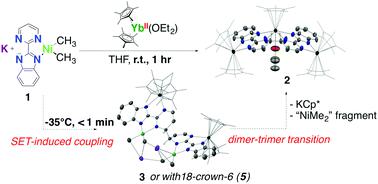当前位置:
X-MOL 学术
›
Inorg. Chem. Front.
›
论文详情
Our official English website, www.x-mol.net, welcomes your feedback! (Note: you will need to create a separate account there.)
Redox activity of a dissymmetric ligand bridging divalent ytter-bium and reactive nickel fragments
Inorganic Chemistry Frontiers ( IF 7 ) Pub Date : 2020-11-20 , DOI: 10.1039/d0qi00952k Ding Wang 1, 2, 3, 4, 5 , Maxime Tricoire 1, 2, 3, 4, 5 , Valeriu Cemortan 1, 2, 3, 4, 5 , Jules Moutet 1, 2, 3, 4, 5 , Grégory Nocton 1, 2, 3, 4, 5
Inorganic Chemistry Frontiers ( IF 7 ) Pub Date : 2020-11-20 , DOI: 10.1039/d0qi00952k Ding Wang 1, 2, 3, 4, 5 , Maxime Tricoire 1, 2, 3, 4, 5 , Valeriu Cemortan 1, 2, 3, 4, 5 , Jules Moutet 1, 2, 3, 4, 5 , Grégory Nocton 1, 2, 3, 4, 5
Affiliation

|
The reaction of a reactive nickel dimethyl 1 bearing a redox-active, dissymmetric ligand, which is obtained by deprotonation of 2-pyrimidin-2-yl-1H-benzimidazole (Hbimpm) with a divalent lanthanide complex, Cp*2Yb(OEt2), affords an unprecedented, trimeric 2 with C(sp3)–C(sp3) bond formation between two ligands in an exo position. Meanwhile, the transient, dimeric species 3 can be isolated with the same ligand coupling fashion, however, with a drastic distorsion angle of the bimpm ligand and reactive NiMe2 fragment, revealing the possible mechanism of this rearrangement. A much more stable dimeric congener, 5, with an exo ligand coupling, is synthesized in the presence of 18-crown-6, which captures the potassium counter ion. The C–C coupling formation between two bimpm ligands results from the effective electron transfer from divalent lanthanide fragments. Without the divalent lanthanide, the reductive coupling occurs on a different carbon of the ligand, nicely showing the modulation of the spin density induced by the presence of the lanthanide ion. The electronic structures of these complexes are investigated by magnetic study (SQUID), indicating a 2F7/2 ground state for each ytterbium in all the heterometallics. This work firstly reports ligand coupling reactivity in a redox-active, yet dissymmetric system with divalent organolanthanides, and the reactive nickel moiety can impact the intriguing transition towards a stable homoleptic, trinulear lanthanide species.
中文翻译:

不对称配体桥接二价和反应性镍碎片的氧化还原活性
反应性镍二甲酯的反应1轴承氧化还原活性,不对称配位体,它是由2 -嘧啶-2-基-1H-苯并咪唑的脱质子化(Hbimpm)与二价镧系元素复合物得到的Cp * 2 OET镱(2),提供了前所未有的三聚体2,在一个外位的两个配体之间形成了C(sp 3)–C(sp 3)键。同时,可以以相同的配体偶联方式分离瞬态二聚体物种3,但是,bimpm配体和反应性NiMe 2具有大的扭曲角片段,揭示了这种重排的可能机制。在18-crown-6(捕获钾抗衡离子)的存在下,合成了具有外型配体偶联的更稳定的二聚体同类物5。两个Bimpm配体之间的C–C耦合形成是由于二价镧系元素片段的有效电子转移所致。如果没有二价镧系元素,则还原偶联发生在配体的不同碳上,很好地显示了镧系元素离子的存在引起的自旋密度的调节。这些复合物的电子结构通过磁研究(SQUID)进行了研究,结果表明2 F 7/2所有杂金属中每个each的基态。这项工作首先报道了在具有二价有机镧系元素的氧化还原活性但不对称的系统中的配体偶联反应性,而活性镍部分会影响向稳定的均安的三核镧系物种的引人注目的转变。
更新日期:2020-12-17
中文翻译:

不对称配体桥接二价和反应性镍碎片的氧化还原活性
反应性镍二甲酯的反应1轴承氧化还原活性,不对称配位体,它是由2 -嘧啶-2-基-1H-苯并咪唑的脱质子化(Hbimpm)与二价镧系元素复合物得到的Cp * 2 OET镱(2),提供了前所未有的三聚体2,在一个外位的两个配体之间形成了C(sp 3)–C(sp 3)键。同时,可以以相同的配体偶联方式分离瞬态二聚体物种3,但是,bimpm配体和反应性NiMe 2具有大的扭曲角片段,揭示了这种重排的可能机制。在18-crown-6(捕获钾抗衡离子)的存在下,合成了具有外型配体偶联的更稳定的二聚体同类物5。两个Bimpm配体之间的C–C耦合形成是由于二价镧系元素片段的有效电子转移所致。如果没有二价镧系元素,则还原偶联发生在配体的不同碳上,很好地显示了镧系元素离子的存在引起的自旋密度的调节。这些复合物的电子结构通过磁研究(SQUID)进行了研究,结果表明2 F 7/2所有杂金属中每个each的基态。这项工作首先报道了在具有二价有机镧系元素的氧化还原活性但不对称的系统中的配体偶联反应性,而活性镍部分会影响向稳定的均安的三核镧系物种的引人注目的转变。


























 京公网安备 11010802027423号
京公网安备 11010802027423号